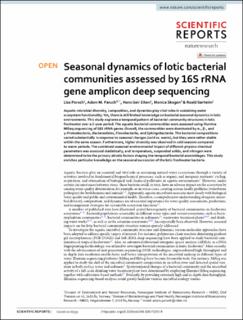Seasonal dynamics of lotic bacterial communities assessed by 16S rRNA gene amplicon deep sequencing
| dc.contributor.author | Paruch, Lisa | |
| dc.contributor.author | Paruch, Adam | |
| dc.contributor.author | Eiken, Hans Geir | |
| dc.contributor.author | Skogen, Monica | |
| dc.contributor.author | Sørheim, Roald | |
| dc.date.accessioned | 2020-12-03T13:09:07Z | |
| dc.date.available | 2020-12-03T13:09:07Z | |
| dc.date.created | 2020-10-02T14:53:09Z | |
| dc.date.issued | 2020-10-02 | |
| dc.identifier.citation | Scientific Reports. 2020, 10 . | en_US |
| dc.identifier.issn | 2045-2322 | |
| dc.identifier.uri | https://hdl.handle.net/11250/2711724 | |
| dc.description.abstract | Aquatic microbial diversity, composition, and dynamics play vital roles in sustaining water ecosystem functionality. Yet, there is still limited knowledge on bacterial seasonal dynamics in lotic environments. This study explores a temporal pattern of bacterial community structures in lotic freshwater over a 2-year period. The aquatic bacterial communities were assessed using Illumina MiSeq sequencing of 16S rRNA genes. Overall, the communities were dominated by α-, β-, and γ-Proteobacteria, Bacteroidetes, Flavobacteriia, and Sphingobacteriia. The bacterial compositions varied substantially in response to seasonal changes (cold vs. warm), but they were rather stable within the same season. Furthermore, higher diversity was observed in cold seasons compared to warm periods. The combined seasonal-environmental impact of different physico-chemical parameters was assessed statistically, and temperature, suspended solids, and nitrogen were determined to be the primary abiotic factors shaping the temporal bacterial assemblages. This study enriches particular knowledge on the seasonal succession of the lotic freshwater bacteria. | en_US |
| dc.language.iso | eng | en_US |
| dc.publisher | Springer Nature | en_US |
| dc.rights | Navngivelse 4.0 Internasjonal | * |
| dc.rights.uri | http://creativecommons.org/licenses/by/4.0/deed.no | * |
| dc.title | Seasonal dynamics of lotic bacterial communities assessed by 16S rRNA gene amplicon deep sequencing | en_US |
| dc.type | Peer reviewed | en_US |
| dc.type | Journal article | en_US |
| dc.description.version | publishedVersion | en_US |
| dc.rights.holder | © The Author(s) 2020 | en_US |
| dc.source.pagenumber | 10 | en_US |
| dc.source.volume | 10 | en_US |
| dc.source.journal | Scientific Reports | en_US |
| dc.identifier.doi | 10.1038/s41598-020-73293-9 | |
| dc.identifier.cristin | 1836641 | |
| dc.source.articlenumber | 16399 | en_US |
| cristin.ispublished | true | |
| cristin.fulltext | original | |
| cristin.qualitycode | 1 |
Tilhørende fil(er)
Denne innførselen finnes i følgende samling(er)
-
Divisjon for bioteknologi og plantehelse [519]
Publikasjoner knyttet til ansatte ved Divisjon for bioteknologi og plantehelse -
Divisjon for miljø og naturressurser [745]
Publikasjoner knyttet til ansatte ved Divisjon for miljø og naturressurser -
Publikasjoner fra CRIStin - NIBIO [4489]
-
Vitenskapelige artikler [1416]

